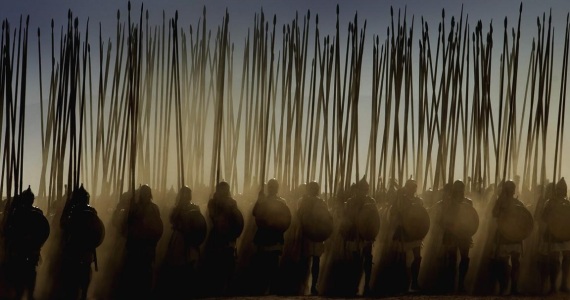
Marathon: 2500 years of History
To most people, Marathon is known for the historic battle and the short distance from the center of the capital. However, you should revise. The area is a complete destination that offers archaeological sites, museums, natural monuments of unique beauty, beaches and a variety of activities. There is another good reason to visit the area this year, as it marks 2500 years since the famous battle of Marathon whose celebration will be supported by a variety of interesting events.
A first time visitor’s impression of the town of Marathon is not indicative of its long history. The few stone houses that are left “narrate” the recent history, development and prosperity this place has known.
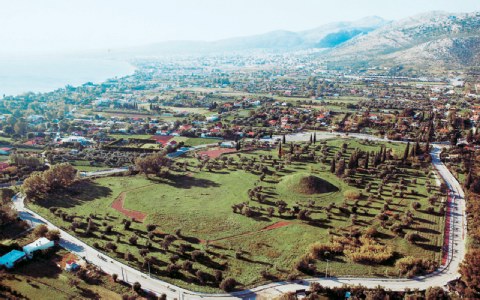
View of Marathon tomb and plain, where the historic battle took place in 490 BC
The fertile plain of Marathon was instrumental in the development and habitation of the region that dates back to antiquity, since the ancient town of Marathon, Trikorythos, Inoi and Provalinthos which constituted the Tetrapolis of Athens. In the late Byzantine period and until the late 18th century, the region experienced abandonment and was mainly used as pasture by Arvanite nomad breeders who by late 13th century, settled in the entire Eastern Attica Region (including Marathon).
Later on, workers in the iron mines of Grammatiko, farmers from Thessaly, refugees from Asia Minor and Sarakatsans settled in the area forming an interesting cultural mosaic.
Apart from Marathon several other villages have been established in the area the inhabitants of which cultivated olive trees , vineyards , wheat , and many vegetables , such as the famous Marathon tomato, in the fertile plain of Marathon, while the arrival of refugees enriched the crops with rice , tobacco and cotton cultivation.
The Early Hellenic cemetery at Tsepi, dated between
3200 and 2000 BC
At the same time livestock farming on the hillsides around Marathon grew significantly and indeed maintained until very recently. Indicative is the fact that in the late 1960s there were two cheese dairies processing eight tons of milk daily.
Marathon is globally known for the battle that took place in 490 BC between Greeks and Persians, but also for the marathon, which gave its name to thousands of endurance races around the world. Especially popular among the inhabitants of Athens, Marathon is an ideal all year round excursion destination, which ideally combines the elements of mountain and sea.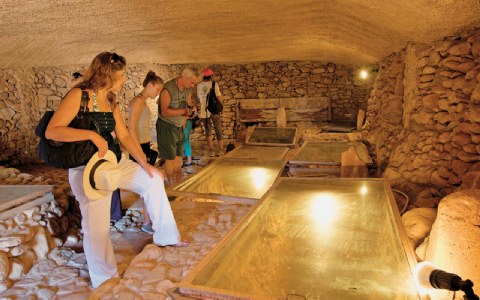
Inside the Plataean Tomb. According to the indications, the bones found in 11 graves belong to Plataean soldiers.
The organized events in celebration of the completion of 2500 years from the Battle of Marathon are expected to attract thousands of visitors. Taken this opportunity we invite you all to take part in these celebrations and get to know one of the most significant historical sites of Greece.
At the Tomb of Marathon Fighters
The great wealth of archaeological discoveries in Marathon is the best confirmation of its glorious history. The most important monument in the region is the Marathon Tomb or Soros, where 192 glorious Athenian warriors who fell during the battle with the Persians were buried.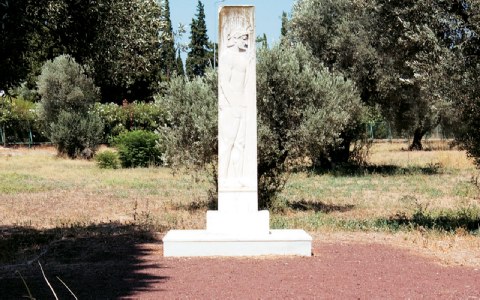 A copy of the grave stele of Marathon fighter Aristion, discovered in Velanideza Attica, is set up at the Marathon Tomb area
A copy of the grave stele of Marathon fighter Aristion, discovered in Velanideza Attica, is set up at the Marathon Tomb area
Excavations carried out in the late 19th century brought to light a thick layer of ash and charcoal, proof that the dead soldiers were burned and buried on the battlefield, which was a great honor for the dead in ancient Athens. It also brought to light pieces of pottery which was the last offering to the dead by their relatives.
The Early Hellenic Period cemetery (3200-2000BC) discovered in location Tsepi is considered of equal importance. Within walking distance from the EH cemetery lies the archaeological museum, in the surrounding area of which another important cemetery of the Middle Helladic period (2000-1300BC) has been discovered. It consists of stone-built tombs, containing cist and shaft graves. Three burial mounds are located indoors while the remaining four outside.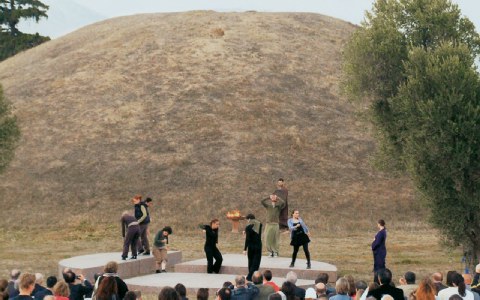 Celebrations of 2,500 years from the Battle of Marathon is supported by numerous events.
Celebrations of 2,500 years from the Battle of Marathon is supported by numerous events.
Inside the fenced area of the museum lies another tomb where, according to indications Plataean soldiers are buried. The discovery brought to light 11 burials, two of which were burned to ashes as well as a grave stele with the name Archia or Archias.
(Visitors wishing to see it may ask the museum employees to open it)
Southeastern of Marathon, next to the old church of Panagia Mesosporitissa, lies a copy of the battle trophy (part of the original is kept in the Marathon museum). Probably set up at the point where the dead Persian soldiers were buried in groups, a statement justified by the large number of human bones found in irregular arrangement. The original trophy made of white marble had, an ionic capital apex that supported a statue (most probably that of Victory).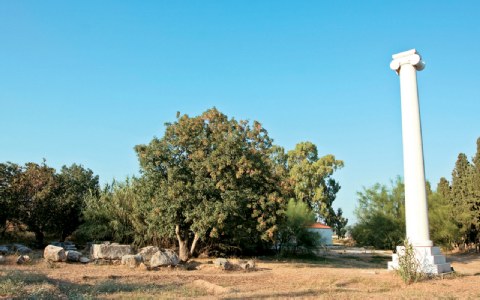 Location where the Battle Trophy copy of the allegedly buried Persian soldiers lies.
Location where the Battle Trophy copy of the allegedly buried Persian soldiers lies.
It is believed that the trophy has been crafted about 30 years after the battle. In the boundaries between Marathon and Nea Makri the temple of the Egyptian gods as well as a Roman bath of the 2nd century AD can also be found.
A visit to the city’s museums
The Marathon Run Promotion Center, or Marathon Museum is considered the "jewel" of Marathon and worldwide best of its kind. Housed in the old primary school of Marathon, was constructed on the initiative of "Athens 2004" organization and sponsored by Alpha Bank. The official inauguration took place in November 2007 and was hold by the President of the Republic of Greece Mr. Karolos Papoulias.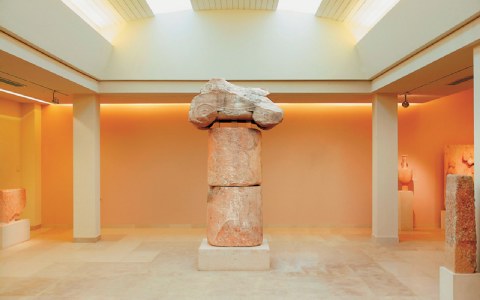
The museum is divided into sections. The first section contains historic Greek athletes’ relics such as medal and fez of the first winner of the Olympic marathon Spiridon Louis, in addition to personal belongings of the 1946 Boston Marathon winner, Stelios Kyriakides.
In another section, torches from various Olympic Games are displayed
(With the older one being that of 1932) along with large dashboards, where all Marathons held from 1896 until today with statistics
(Winners, performances, times, weather conditions etc.) are listed.
In the next section, portraits and medals won by some great Greek marathon runners, like Chris Vartzakis , Maria Polyzou , Takis Skoulis , Nikos Polias , Spyros Andriopoulos , Michael Koussis , Christos Sotiropoulos , Thanasis Ragazos , Panagiota Nikolakopoulou- Louvi , and several Paralympics sport winners are being displayed.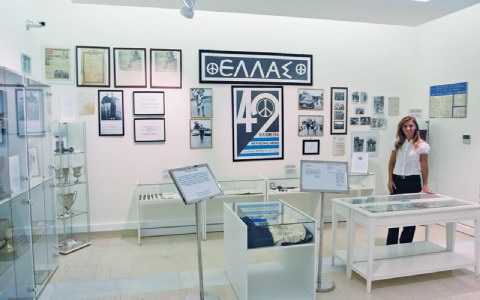
Furthermore you will see medals and memorabilia from various marathons that are being held throughout the Earth (the International Marathon Federation has recorded 1,700), as well as a permanent exhibition of photographs and texts on the history of the Olympic Marathon, donation of Lausanne’s Olympic Museum.
At a separate section in the museum, personal objects and archival material of the Balkan-Games winner - pacifier Grigoris Lambrakis are displayed. The blood-stained clothes he wore the day he was murdered is perhaps the most important exhibit.
The museum has been acknowledged by the International Marathon Federation as the best of its kind. Maria Polyzou, museum designer and director, former marathoner champion, is responsible for giving you a tour. (Open daily: Morning: 10.00-12.00, Afternoon: 17.00- 19.30 except Tuesdays, Sundays, tel: 22940 67 617).
The Marathon archaeological museum that can be found in Vranas exhibits important findings of the region. Some of these findings include, part of the trophy of the battle of Marathon, pottery from the Tomb, statues from the temple of the Egyptian gods in Brexiza , tombstones, findings from cave Panos and embossed inscriptions from the Herodes Atticus estate. The tour continues outdoors, at the Middle Helladic cemetery and the tomb of Plataeans.
Near the dam, the museum of EYDAP (Athens Water Supply and Sewerage Company or AHWSF), can be found, where photographs and documents from the dam are exhibited. However the museum is only open to school visits (information tel: 210 8141355, 8.00-14.00 hrs).